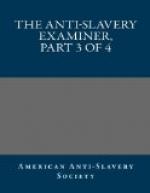“The back of the poor little sufferer, (which we ourselves saw,) was actually cut into strings, and so perfectly was the flesh worn from her limbs, by the wretched treatment she had received, that every joint showed distinctly its crevices and protuberances through the skin. Her little lips clung closely over her teeth—her cheeks were sunken and her head narrowed, and when her eyes were closed, the lids resembled film more than flesh or skin.
“We would desire of our northern friends such as choose to publish to the world their own version of the case we have related, not to forget to add, in conclusion, that the owner of this little girl is a foreigner, speaks against slavery as an institution, and reads his Bible to his wife, with the view of finding proofs for his opinions.”
Rev. WILLIAM SCALES, of Lyndon, Vermont, gives the following testimony in a recent letter:
“I had a class-mate at the Andover Theological Seminary, who spent a season at the south,—in Georgia, I think—who related the following fact in an address before the Seminary. It occasioned very deep sensation on the part of opponents. The gentleman was Mr. Julius C. Anthony, of Taunton, Mass. He graduated at the Seminary in 1835. I do not know where he is now settled. I have no doubt of the fact, as be was an eye-witness of it. The man with whom he resided had a very athletic slave—a valuable fellow—a blacksmith. On a certain day a small strap of leather was missing. The man’s little son accused this slave of stealing it. He denied the charge, while the boy most confidently asserted it. The slave was brought out into the yard and bound—his hands below his knees, and a stick crossing his knees, so that he would lie upon either side in form of the letter S. One of the overseers laid on fifty lashes—he still denied the theft—was turned over and fifty more put on. Sometimes the master and sometimes the overseers whipping—as they relieved each other to take breath. Then he was for a time left to himself, and in the course of the day received FOUR HUNDRED LASHES—still denying the charge, Next morning Mr. Anthony walked out—the sun was just rising—he saw the man greatly enfeabled, leaning against a stump. It was time to go to work—he attempted to rise, but fell back—again attempted, and again fell back—still making the attempt, and still falling back, Mr. Anthony thought, nearly twenty times before he succeeded in standing—he then staggered off to his shop. In course of the morning Mr. A. went to the door and looked in. Two overseers were standing by. The slave was feverish and sick—his skin and mouth dry and parched. He was very thirsty. One of the overseers, while Mr. A, was looking at him, inquired of the other whether it were not best to give him a little water. ‘No. damn him, he will do well enough,’ was the reply from the other overseer. This was all the relief gained by the poor slave. A few days after, the slaveholder’s son confessed that he stole the strap himself.”




